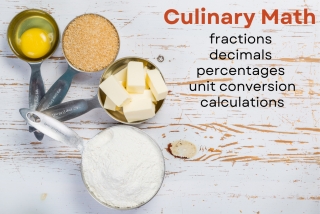
Culinary Math Teaching Series: Advanced Unit Conversions
03 April 2023A descriptive visualization of weight and volume conversion helps math-stranded students understand complex problems.
By Linda Blocker, Associate Professor at the State University of New York at Delhi
Feedback & comments: This email address is being protected from spambots. You need JavaScript enabled to view it.
We explored the fluid ounce debacle of culinary math in last month’s article. I will dive into how I teach conversions between weight and volume in this article. Before I found my passion for teaching culinary math, I was a middle and high school math teacher. I needed to learn the specifics of teaching culinary conversion to do my current job. I am grateful that the difference between weight and volume initially didn’t come easy to me.
While working on conversion between volume and weight, I had an epiphany that made the earth shake for me. It came in the form of the two islands. As I teach the approach that helped me, I tell my students that they, too, may have their own aha moment while practicing. This type of math is hard until it isn’t anymore – when you “see” it. I truly enjoy the smiling reports from students saying, “I got it while I was doing my homework last night!”
Here is the visual I draw on the whiteboard:

I ask for specific measurements that live on each island. As students share them, I write them on the appropriate island. I go on to explain that the only way to get from one island to the other (or convert) is to have the appropriate conversion fact, such as 1 cup (volume) of shredded cabbage weighs 4 ounces (weight). I refer to the conversion fact as a bridge between the two islands. It is also, coincidentally, the name of the conversion method I teach.
At this point, I offer a practice problem and use the islands to solve it. Here is an example:
Practice Problem:
A recipe for cabbage and potato soup calls for 1 ¼ qts. of shredded green cabbage. How many pounds of cabbage do you need for this recipe if a cup of cabbage weighs 4 ounces?
Solution:
The problem is asking the student to convert 1 ¼ qts. (volume) of shredded cabbage to pounds (weight) using the given conversion fact. I explain that we must start with what we know. We know that we have 1 ¼ qts. Then, on the Island of Volume oval, I write the conversion of 1 ¼ qts. to cups. We convert to cups first because the volume-to-weight fact is given in cups. I set up the solution on the islands and proceed with converting using the bridge method, as shown below.

We finish on the Island of Weight with the answer, in pounds. We discuss that if each cup of cabbage weighs ¼ pound, it makes sense for 5 cups (1 ¼ qts.) to weigh 1.25 pounds.
I use the islands model for a few practice problems and then have them practice independently. I do not continue to use the islands after students demonstrate their understanding of converting between volume and weight. Some students do not need this visualization to solve this or other problems. However, I believe all students benefit from this visual aid that supports their understanding of the math they do to convert quantities.
Next month, I will share my Joe Careless Food Cost Form, a recipe costing activity that helps students solidify their understanding.
